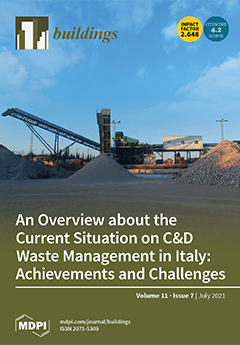The objective of this paper is to investigate the effect of improving indoor air quality with indoor plants. As a methodology, two target classrooms with the same size (120.64 m
2) and 32 students per room were selected. Then, 48 areca palm
[...] Read more.
The objective of this paper is to investigate the effect of improving indoor air quality with indoor plants. As a methodology, two target classrooms with the same size (120.64 m
2) and 32 students per room were selected. Then, 48 areca palm pots (average leaf area of 300 cm
2/pot) were placed, and the plant density was 14.68% of the floor area. Subjective assessment for general questions, learning motivation, perceived air quality, and SBS symptoms was conducted at 5 min after the class started and 5 min before the class ended. The results showed that the CO
2 concentration by respiration of the students (average of 1873 ppm) exceeded the regulatory standard (1000 ppm), but the students did not recognize the indoor CO
2 concentration. The increase in CO
2 concentration in the classroom was lower in the case with plant placement (624 ppm) compared with the case without plant placement (about 1205 ppm). It was statistically proven that the CO
2 concentration by respiration could be reduced by 50% if the indoor plant leaf area density were maintained at about 14.68% of the floor area. In the case with plant placement, the students perceived the indoor air quality to be 40% fresher and showed a 140% higher acceptability. Moreover, the complaining of SBS symptoms was improved by 108%, and the students’ perception that it was better to focus on learning increased by about 120%. As the awareness of sustainability increases, indoor plants will be more actively placed in the United Arab Emirates. Indoor plants not only provide a visual green effect to improve human comfort but also purify indoor air pollutants.
Full article





